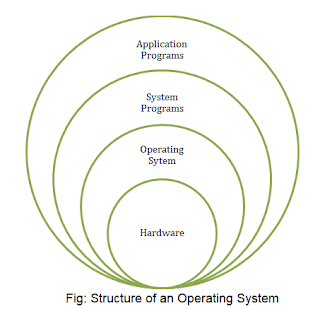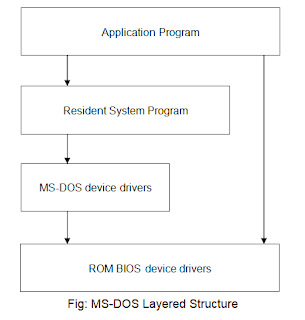Structure of Operating System:
The structure of operating system consists of four layers. These are hardware, software, system programs and application programs. The following figure depicts the structure of OS.
The hardware part consists of CPU, main memory, IO devices,
secondary storage etc. The software includes routines for process management,
memory management, IO control, file management. The system program layer
consists of compilers, assemblers, linker etc. The application programs depend
on the users.
Simple Structure:
Simple structure OS consist of small, simple and limited
systems. Their structure is not well defined. For ex. MS - DOS is a simple structure
OS.
It was initially written to provide the most functionality in
the least space. The system started as a small and grew beyond its original
scope. Levels were not well separated and as such programs could access IO
devices directly. There was no dual user or kernel mode.
Layered Approach:
At the bottom layer is the hardware layer having a layer
number 0. The topmost layer (layer N) is
the user interface. An OS could be
structured to contain many layers. Each
layer uses the interface provided by the layer below it and provides a more
intelligent interface to the layer above it.
Layered structure provides good modularity. Each layer of the
OS forms a module with a clearly defined functionality and interface with the
rest of the OS. It simplifies debugging, system verification and provides
facility of information hiding.
All the data and program are hidden from other module. Debugging is done at first layer. While
debugging, if any error is found, the error must be on that layer because the
layers below it are already debugged. Each
layer hides the existence of certain data structures, operations and hardware
from higher level layers.
Layered approach required careful definition of the layers
because a layer can use only those layers below it. Problem with layered
implementations is that they tend to be less efficient than other types.
The following figure shows a layered kernel:



No comments:
Post a Comment